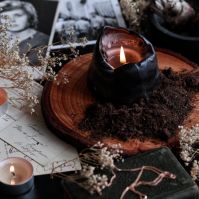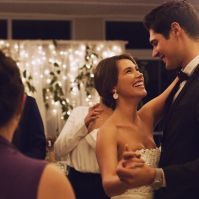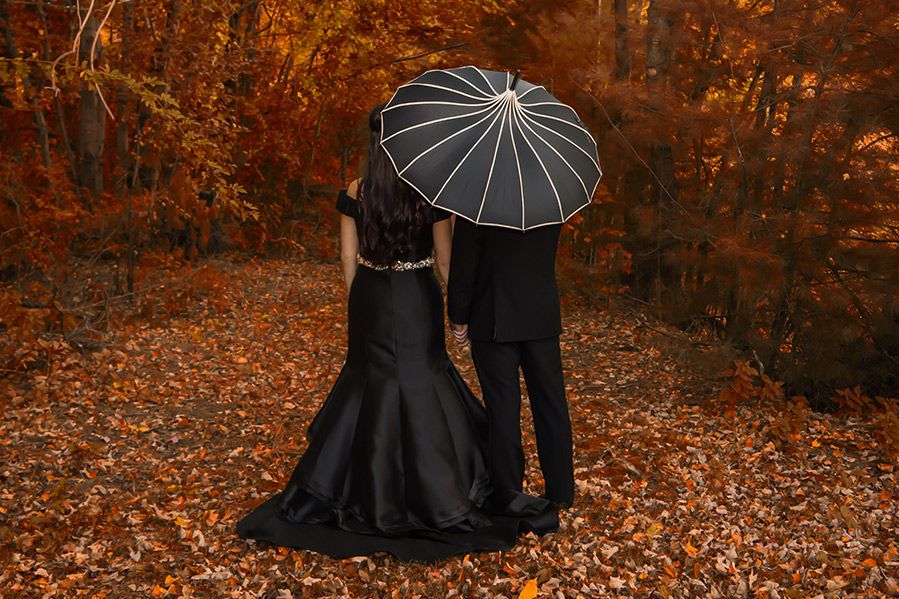
It’s no secret that witchcraft has a long and complicated history in America. It was the basis for persecution during the infamous Salem Witch Trials of the 17th century. Witchcraft is also associated with a minority religion, Wicca – a branch of pagan faith that for years was ignored or dismissed outright by much of mainstream America.
But despite centuries of discrimination and disregard, witches never went away. In fact, they’re arguably more influential than ever. Today, Wicca is one of the fastest growing faiths in the United States, experiencing a rapid rise in acceptance in recent years. Some practitioners are even making a living by selling their witch services on Etsy.
With this renewed interest in witchcraft, it should come as no surprise that witchy weddings are becoming more popular as couples approach the wedding planning process seeking to create a unique experience that speaks to their beliefs and interests.
But how does a witchcraft wedding work, and what customs do they include?
What Is a Witchcraft Wedding?
In many ways, a witchcraft wedding looks similar to any other marriage ceremony. There are flowers, an ordained officiant, a wedding ceremony script, and – most importantly – a couple in love.
But witchcraft weddings have some key differences and unique traditions which set them apart from your typical wedding ceremony. There are also a wide variety of wedding customs beneath the umbrella of “witchcraft” – some spiritual, and others secular.
There’s no doubt about it: many witch-themed weddings have a strong religious element. However, the term is also used more broadly by eclectic witches, spiritual seekers, and nature-based practitioners.
Let’s start by exploring the spiritual side of witchy weddings.
What Is the Difference Between Wiccan and Pagan?
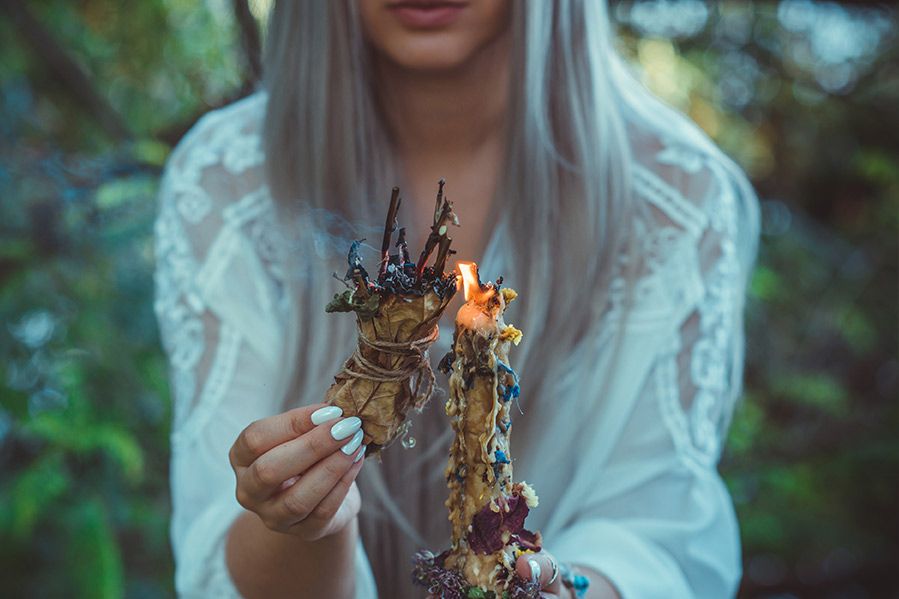
First, we’ll define some terms. “Paganism” is a catch-all term for numerous faith traditions, and each family of pagan beliefs has its own rich, unique history.
When someone says “witch wedding” or “witchcraft wedding” they may be referring to a specific branch of paganism known as Wicca, and a ceremony that invokes Wiccan traditions.
Below, we’ll break down common Wiccan and Pagan wedding traditions and explain how they fit into a larger ceremony format.
What Are Common Witch Wedding Themes?
However, there are a handful of practices you’ll see across many or most styles of Wiccan and Pagan weddings. Those include:
- Handfasting: Handfasting ceremonies are common at Pagan weddings, as most Pagan couples choose this ancient practice to represent their commitment to one another.
- Altar With Offerings: Altars are another common sight at Pagan weddings. Offerings like candles or incense are placed on the altar either as an offering to the gods or in tribute to the couple
- Dark Wedding Attire: Dark colors are common at Pagan weddings, with many brides opting for a black dress instead of the traditional white. If you’re a guest at a Pagan wedding, make sure you check the dress code beforehand!
- Sage or Incense Burning: Before a Pagan wedding occurs, it is common for the officiant or couple to bless the space with the burning of sage or incense, cleansing the space of any bad energy.
- Sacred Circle: Pagan weddings often feature the guests seated in a circle either partially or fully encompassing the couple, rather than the traditional row of seats at other wedding ceremonies.
- Sword Ceremony: In ancient times, Viking brides and grooms would exchange their family swords at the altar to seal their union. At the altar, modern couples exchange swords as a representation of their trust in one another.
- A Nature Setting: Because Paganism is a faith with reverence and respect for nature, many, but not all, Pagan wedding ceremonies are set outdoors, often in a wooded area.
What Are the Different Types of Paganism?
While “Pagan” means different things to different people, there are three primary faith traditions that fall under the umbrella of paganism: Wicca, Druidry, and Heathenry. Some scholars have compared these branches to denominations in other faiths.
Let’s explore these different schools of belief and the wedding customs they practice.
The Various Schools of Wicca
Modern Wicca is a nature-oriented faith strongly influenced by New Age movements and feminism. Adherents sometimes refer to themselves as “witches.”
Within their faith, Wiccans honor the elemental forces of the earth – fire, air, water, and spirit – and the changing of the seasons and the lunar cycle are held sacred. Though some Wiccans categorize themselves as spiritual rather than religious, others believe strongly in the influence of gods, goddesses, and spirits on the natural world.
Several types of Wicca have emerged:
Gardnerian Wicca. Founded in the 1950s by a man named Gerald Gardner in the UK. Gardner helped re-popularize Wicca in the modern world by studying traditional Pagan faith traditions and organizing followers into covens, led by a High Priest or High Priestess.
Dianic Witchcraft. This is a feminist denomination focused on female empowerment. It differs from other Wiccan traditions in that it is monotheistic and followers worship only the Great Goddess (as opposed to numerous deities).
Alexandrian Wicca. A ritual-heavy tradition founded in the 1960s that blends Gardnerian structure with ceremonial magic influences.
Wiccan Wedding Customs
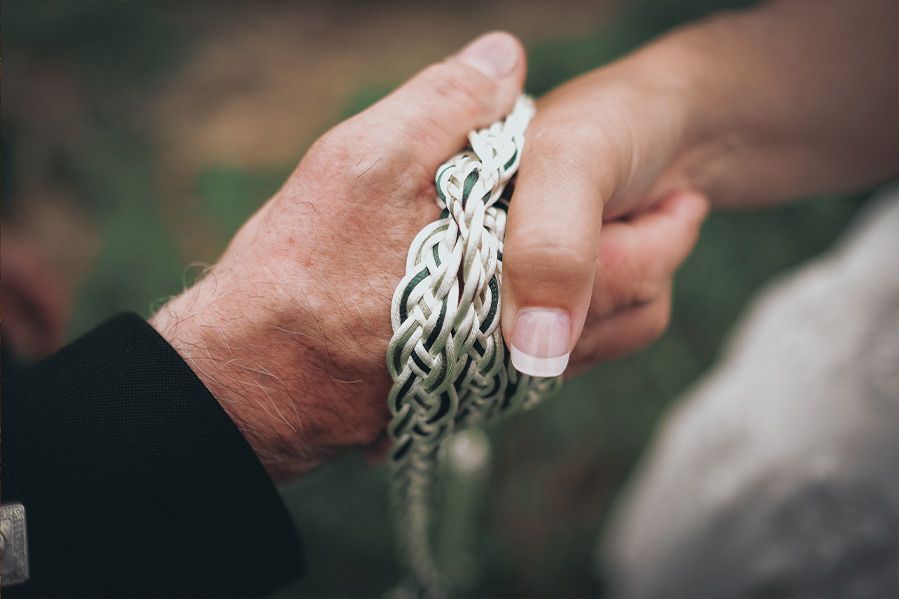
The Handfasting Ceremony
While customs vary between these three traditions, most Wiccan weddings ceremonies will center around the ritual of handfasting.
During a handfasting, the wedding officiant will use a handfasting ceremony script to guide the proceedings as they tie a special handfasting cord or ribbon around the couple’s hands to symbolize their unity and the beginning of their new life together.
RELATED:How to Tie a Handfasting Knot
In Wiccan tradition, handfasting is often done in a sacred circle, with guests seated in a full circle around the couple.
Jumping of the Broom Ceremony
Another Pagan wedding custom adopted by some couples is the jumping of the broom, a ceremonial act where the couple hurdles a broom together to symbolize leaving the past behind and starting a new life together.
Because it involves a broom, some people naturally (but mistakenly) believe this to be a Wiccan ceremony. In fact, jumping the broom is a meaningful tradition with roots in several cultures, including Celtic and Romani.
In the U.S., it became a cherished custom in African American communities during the era of slavery, when enslaved people were often denied the right to marry legally.
Today, it’s a powerful symbol of love and resilience for many couples – Pagan or otherwise.
Druidry Wedding Customs
Druidry is another popular movement within the Pagan tradition. Modern Druidry takes inspiration from the historic Druids of the ancient Celts. Modern Druids venerate nature and seek harmony between themselves and the world surrounding them. They believe that everything – humans, animals, plants, and even nonliving things like streams and stones – have an inherent value and purpose in the natural world.
Because Druidry holds such reverence for nature, you can expect a Druid wedding to take place outdoors. Druidic weddings are raucous, joyous occasions, and you’ll likely be partying late into the night in celebration of the couple, the world, and their place in it.
Heathenry Wedding Customs
Modern Heathenry is a new religious movement which draws inspiration from the peoples of pre-Christian Germanic Europe, notably Vikings. Within the modern context, “Heathenry” is a re-appropriation of what was once a derogatory term.
The most common faith traditions within Modern Heathenism is Asatru, an earth-centered faith of which believers are expected to follow an ethics code called the Nine Noble Virtues, and Norse Paganism, a modern-day faith whose followers worship Norse gods like Thor and Freya.
To get a sense of what an Asatru wedding ceremony might look like, check out this Asatru handfasting wedding script.
If you’re attending a Viking wedding, you may just see a modern-day sword ceremony. Though brides and grooms are unlikely to have ancestral family swords to exchange, the symbolism and meaning is no less pronounced. And with the first sword exchange in generations, they may just start a new family tradition of their own!
Are All Witchy Weddings Religious?
Not necessarily. While many witchcraft-inspired weddings draw from religious traditions like Wicca, Druidry, or Heathenry, an increasing number of couples are choosing to host secular “witchy” weddings that embrace the aesthetic, symbolism, and nature-based rituals of witchcraft without tying them to specific spiritual beliefs.
These ceremonies might include handfasting, broom-jumping, candle magic, or tarot readings purely as personal or symbolic gestures, not as acts of religious devotion. For example, a couple might burn sage to “clear the air” emotionally, rather than as part of a spiritual cleansing.
Secular witchy weddings often focus on themes of empowerment, natural cycles, and intention-setting. This style blends mystical imagery with modern meaning but does so without invoking gods, deities, or any sort of structured theology.
This secular style of witch-themed wedding is ideal for couples who resonate with witchcraft’s visual and emotional symbolism but don’t identify as Pagan or Wiccan.
Celebrating Love Through Witchcraft Traditions
Whether rooted in Wicca, Druidry, Heathenry, or a personalized blend of beliefs, witchcraft wedding ceremonies offer couples a deeply symbolic, nature-honoring, and powerfully spiritual way to celebrate their union. These rituals – from handfastings and sacred circles to sword exchanges and altar offerings – aren’t just visually striking; they’re rich with intention and meaning.
At their core, witch weddings are about more than aesthetics or alternative flair. They’re about honoring ancient traditions, affirming a deep connection to the Earth and cosmos, and casting a sacred circle around love itself. For couples who feel called to these paths, a witchcraft wedding can be a truly magical start to a shared life.
